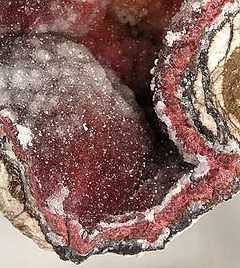Roselite
| Roselite | |
|---|---|
|
Roselite druse in a vug from Morocco (size:12.8 x 8.5 x 5.9 cm) | |
| General | |
| Category | Arsenate minerals |
| Formula (repeating unit) | Ca2(Co2+, Mg)[AsO4]2·H2O |
| Strunz classification | 08.CG.10 |
| Crystal symmetry | Monoclinic 2/m prismatic |
| Unit cell | a = 5.801 Å, b = 12.898 Å, c = 5.617 Å; β = 107.42°; Z = 2 |
| Identification | |
| Color | Dark rose red, pink |
| Crystal habit | Elongated crystals and spherical aggregates and druses |
| Crystal system | Monoclinic |
| Twinning | Common as composition plane, contact twins and fourlings |
| Cleavage | {010} Perfect |
| Mohs scale hardness | 3.5 |
| Luster | Vitreous |
| Streak | Light red |
| Specific gravity | 3.69 |
| Optical properties | Biaxial (-) |
| Refractive index | nα = 1.725 nβ = 1.728 nγ = 1.735 |
| Pleochroism | Visible |
| 2V angle | Calculated: 68° |
| References | [1][2][3] |
Roselite is a rare arsenate mineral with chemical formula: Ca2(Co,Mg)[AsO4]2·H2O. It was first described in 1825 for an occurrence in the Rappold mines of Schneeberg, Saxony, Germany and named by Armand Lévy after German mineralogist Gustav Rose.[1] It occurs in cobalt bearing hydrothermal environments and was associated with veins of quartz and chalcedony in the type locality.[1][3] It has also been reported from Italy, Morocco, Chile, British Columbia and several locations in Germany.[1]
References
| Wikimedia Commons has media related to Roselite. |
